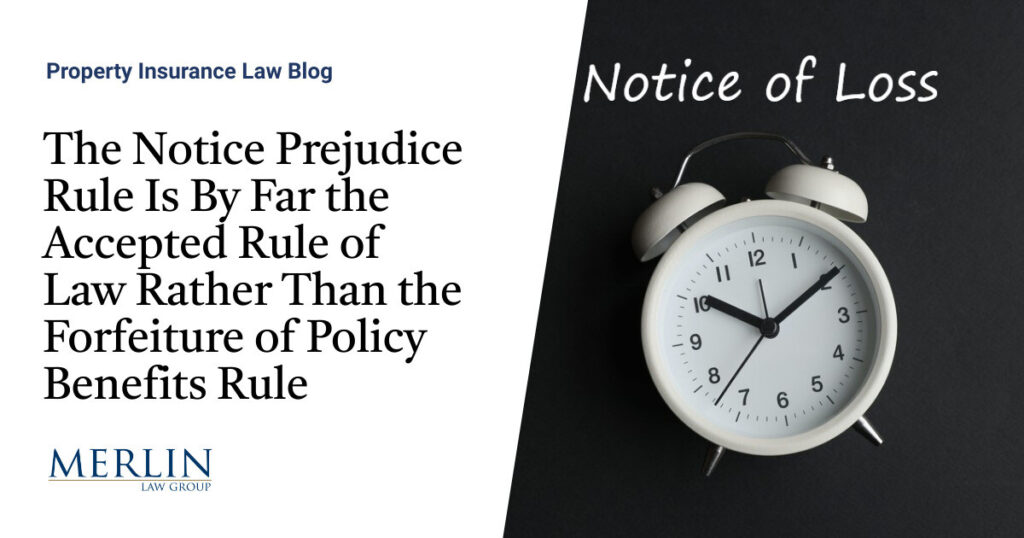The Notice Prejudice Rule Is By Far the Accepted Rule of Law Rather Than the Forfeiture of Policy Benefits Rule

An article written by Matthew Sellers, “Can an insurance carrier reject a homeowner’s claim if it is late?” appears slightly misleading regarding the Colorado Supreme Court case, noted in The Doom and Gloom Assumes a Costume of Plume—The Insurance Industry Needs to Stop Being So Negative and Watch Out for Its Customers. Sellers wrote:
[T]he Supreme Court of Colorado extended the application of the notice-prejudice rule to occurrence-based first-party homeowners’ insurance policies. This rule requires an insurer to demonstrate that it was prejudiced by the insured’s late notice of a claim before denying coverage based on the untimeliness of the claim. This marks a departure from the traditional approach that allowed insurers to deny claims based on late notice without proving prejudice.
…
This development underscores the dynamic nature of insurance law and the potential for legal precedents to evolve. Insurance professionals should stay informed about legal trends and regulatory changes that could affect policy language, claims processing, and the overall insurance market.
If I did not know better, reading this article implies that the Colorado Supreme Court did something different from the majority of other states. In fact, only a few states apply the draconian forfeiture rule, as explained by insurance law professor Johnny Parker in his article, The Role of Prejudice in Resolving Insurance Condition Clause Disputes: The Good, The Bad, & The Ugly. 1
Law Professor Johnny Parker
Colorado followed the same rule as the vast majority of states that use the notice prejudice rule, which Professor Parker noted is “the primary tool used by courts to resolve insurance disputes that arise out of an insured’s failure to comply with a condition clause.” Parker then classified the three methods or rules as the good, bad, or ugly:
These classifications are based on several variables consisting of: (1) whether the prejudice rule has been adopted; (2) the extent to which it has been applied to condition provisions other than notice conditions; (3) express restrictions or limitations on the application of the prejudice rule; and (4) who has the burden of proving or disproving prejudice.
Section II.C concludes that a majority of jurisdictions require insurers to prove that they were actually prejudiced by the insured’s noncompliance. In jurisdictions classified as good, the law is characterized by: (1) recognition of the rule’s applicability to most, if not all, condition provisions; (2) absence of express restrictions on expanding the doctrine’s application; and (3) allocation of the burden of proof on the insurer.
In jurisdictions classified as bad, prejudice jurisprudence is restricted in its application to two or fewer condition provisions. The law in these jurisdictions also expressly recognizes that the rule is not applicable beyond specific condition provisions and/ or specific types of policies. Many of the jurisdictions whose law is classified as bad also allocate the burden of disproving prejudice to the insured, thus recognizing a presumption of prejudice in favor of the insurer.
In jurisdictions classified as ugly, the law continues to adhere to the strict or literal interpretation approach to resolving insurance contract disputes. These jurisdictions engage in the traditional condition precedent/condition subsequent analysis, which favors the drafter of the policy. Consequently, if the condition constitutes a condition precedent, which in most instances it will, or expresses the consequences of an insured’s failure to comply, coverage is void regardless of whether the insurer was prejudiced.
Parker noted that only five jurisdictions, Arkansas, Hawaii, Mississippi, Virginia, and the District of Columbia, use the forfeiture rule, which insurance company attorneys were unsuccessfully arguing for in the recent Colorado case. Professor Parker further commented on how much criticism this rule of law and cases have received:
It is also worthy of note that the law in these jurisdictions has been thoroughly repudiated and rejected by a majority of jurisdictions. It has been abandoned by the vast majority of jurisdictions that originally followed it.
If there is a trend, it would be a challenge to and then a change of the law in those five remaining jurisdictions still following the antiquated forfeiture rule.
If you are deeply interested in the development of this area of insurance law, Professor Parker’s work is an excellent analysis.
Thought For The Day
The difference between the almost right word and the right word is really a large matter—it’s the difference between the lightning bug and the lightning.
—Mark Twain
1 Johnny Parker, The Role of Prejudice in Resolving Insurance Condition Clause Disputes: The Good, The Bad, & The Ugly, 47 U. Mem. L. Rev. 779 (2017).







